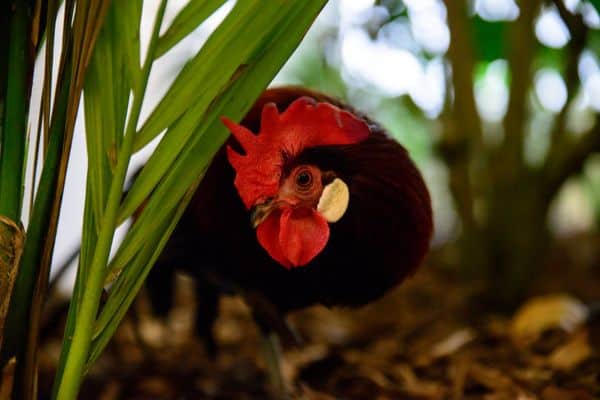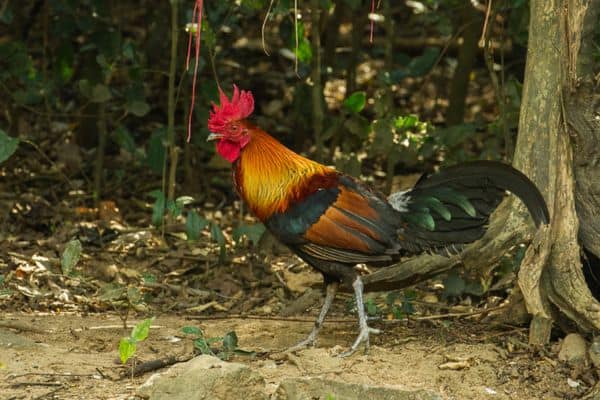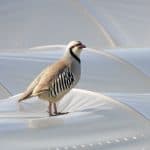Common Name: Red Junglefowl
Scientific Name: Gallus gallus| Size | Diet | Range in Hawaii | Status in Hawaii |
|---|---|---|---|
| 18 in. - 20 in. | seeds, fruits, insects, small animals like lizards and rodents, and even snakes | Common on all islands | Least Concern |
The Red Junglefowl (Gallus gallus) is a tropical bird that ranges across much of Southeast Asia and parts of South Asia. It is the wild ancestor of the domestic chicken and has contributed genetic material to the gene pool of other junglefowl species. Interestingly, the Red Junglefowl has also been introduced to Hawaii, where it has established feral populations and is considered an invasive species.
Red Junglefowl
Appearance

The Red Junglefowl is a striking bird with a colorful appearance. The male measures approximately 25-30 inches in length and has bright red feathers on its head, neck, and back, with iridescent green and blue feathers on its wings and tail.
Its comb and wattles are bright red, and its legs and feet are a deep yellow. The female is smaller, measuring approximately 18-20 inches in length, and is less showy with brown feathers that are mottled with black and white, and a smaller, less colorful comb and wattles. Both sexes have a distinctive curved spur on their legs that they use for defense and territorial disputes.
Diet
The bird species is an omnivorous bird that feeds on a variety of foods. Its diet includes seeds, fruits, insects, small animals like lizards and rodents, and even snakes.
Red Junglefowl are also known to eat grains, which is one reason they have been domesticated and bred to create the domestic chicken. In the wild, they forage on the forest floor, scratching and pecking at the ground to uncover food.
Behavior
These birds are highly social and live in groups called flocks. Within the flock, there is a strict hierarchy with a dominant male at the top, followed by subordinate males and females.
The dominant male will defend his territory and mating rights through displays of aggression, such as fluffing his feathers, puffing out his chest, and making loud calls. The females will lay their eggs in a communal nest, which is then incubated by the dominant male.
Red Junglefowl are also known for their ability to fly short distances and roost in trees at night for protection from predators.
Nesting
They construct communal nests where several females lay their eggs. The dominant male incubates the eggs and defends the nest from predators and other males.
Once hatched, the chicks are precocial and capable of leaving the nest within a day. The mother cares for the chicks, while the dominant male continues to provide protection and guidance as they grow.
Habitat

This bird species inhabit a variety of habitats, including tropical and subtropical forests, grasslands, and scrublands. They prefer areas with dense vegetation and access to water sources.
These birds are also known to live near human settlements, where they can find food and shelter. However, they are sensitive to habitat disturbance and are threatened by deforestation and habitat loss.
Range
Red Junglefowl have been introduced to all eight of the major Hawaiian Islands, where they have established feral populations. These islands include the Big Island, Maui, Oahu, Kauai, Molokai, Lanai, Niihau, and Kahoolawe.
The birds were first brought to Hawaii by Polynesian settlers and later introduced by Europeans for food and sport. Today, they are considered an invasive species and are a threat to native flora and fauna.
Conservation Status

This species is listed as a species of “Least Concern” by the International Union for Conservation of Nature (IUCN). However, some populations are threatened by habitat loss, hunting, and hybridization with domestic chickens.
In some areas, conservation efforts are being made to protect the wild populations of Red Junglefowl and their habitats. In Hawaii, for example, the state has implemented programs to control feral populations and protect native species from their impacts.
Overall, the conservation status of the Red Junglefowl varies depending on the region and the specific threats they face.
Interesting Facts
1. They are highly social birds
They live in highly social groups called flocks, with a strict hierarchy and dominant male at the top.
2. They feed on a variety of foods
These birds are omnivorous and feed on a variety of foods, including seeds, fruits, insects, small animals, and even snakes.
3. Capable of flying short distances
Red Junglefowl are capable of flying short distances and roost in trees at night for protection from predators.
4. A wild ancestor of the domestic chicken
It is the wild ancestor of the domestic chicken and has contributed genetic material to the gene pool of other junglefowl species.
5. A popular game bird
This bird species is a popular game bird and is hunted for sport and food in many parts of the world.
6. Known for their loud calls
These birds are known for their loud calls, which are used for communication within the flock and to attract mates.
7. They can survive in extreme conditions
The Red Junglefowl is a hardy bird and can survive in extreme conditions, including high altitudes and cold temperatures.
Frequently Asked Questions
1. How did Red Junglefowl get to Hawaii?
Red Junglefowl were first brought to Hawaii by Polynesian settlers and later introduced by Europeans for food and sport.
2. Can Red Junglefowl be kept as pets?
Yes, Red Junglefowl are sometimes kept as backyard chickens or in the pet trade.
3. What is being done to control feral populations of Red Junglefowl in Hawaii?
The state of Hawaii has implemented programs to control feral populations and protect native species from their impacts.
4. What is the lifespan of a Red Junglefowl?
In the wild, they can live up to 7 years, while domesticated chickens can live up to 10 years or more.
5. Can Red Junglefowl hybridize with domestic chickens?
Yes, they can hybridize with domestic chickens, which can lead to genetic pollution and a loss of genetic diversity in wild populations.




